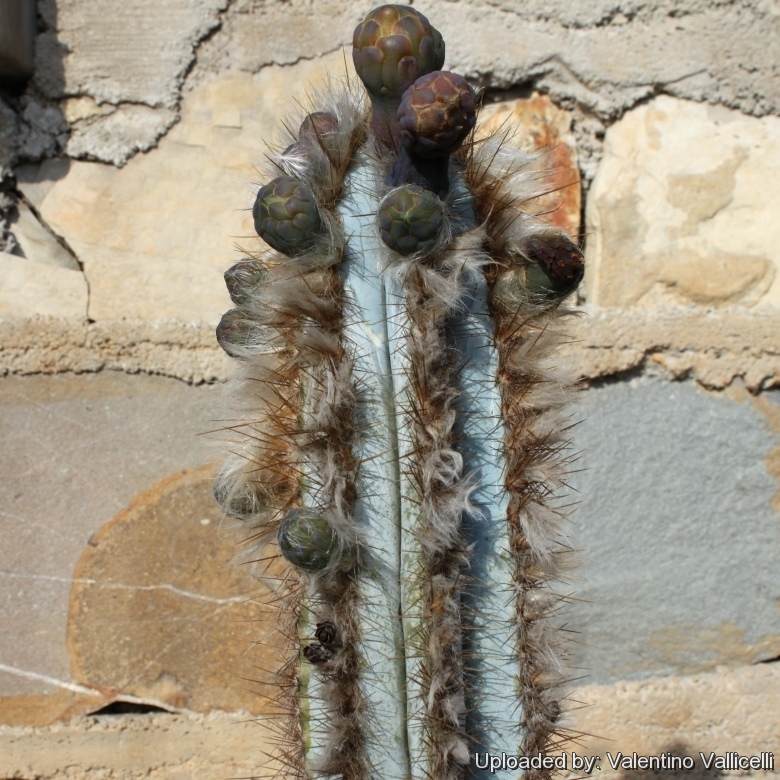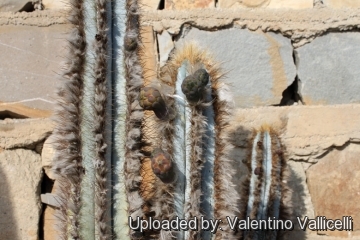= Pilosocereus palmeri (Rose) Byles & G.D.Rowley
Cact. Succ. J. Gr. Brit. xix. 67 (1957).
Accepted Scientific Name: Pilosocereus leucocephalus (Poselg.) Byles & G.D.Rowley
Cact. Succ. J. Gr. Brit. 19: 67. 1957

Cereus palmeri (Pilosocereus palmeri) Photo by: Valentino Vallicelli
Origin and Habitat: Mexico (mainly states of Querétaro, Tamaulipas and Veracruz).
Altitude: 400-1000 metres above sea level
Type locality: Near Victoria, Mexico.
Habitat: Pilosocereus palmeriSN|6732]]SN|6732]] inhabits tropical deciduous forest, xerophyllous scrub, and submontane forest. It germinates in the shade of plant canopies and in soil-filled rock crevices than in flat open areas. It is mainly bat-pollinated although to a lesser degree, diurnal visitors also caused some fruit set. It is partially self-compatible but unable to set fruit without visitors. The habitat of Pilosocereus palmeriSN|6732]]SN|6732]] is home to succulent flora and is particularly rich in local endemics such as: Acanthocereus pentagonusSN|4326]]SN|4326]], Selenicereus pteranthusSN|7536]]SN|7536]], Opuntia puberula and many other. It is widespread and common but threatened by localized small-scale deforestation for cattle and agriculture.
Synonyms:
See all synonyms of Pilosocereus leucocephalus
Common Names include:
ENGLISH: Woolly Torch, Old Man Cactus, Old Man of Mexico
RUSSIAN (Русский): Пилозоцереус Палмера
SPANISH (Español): Cabeza de viejo, Tuno, Órgano, Pitayón, Cabeza blanca
Description: Pilosocereus palmeriSN|6732]]SN|6732]] is is one of the several morphological or local forms of Pilosocereus leucocephalusSN|6720]]SN|6720]]. It is a beautiful and well known tree-like cactus that hardly needs an introduction, with its blue ribbed stem tufted in thick silky wool from which near the tops emerge short, funnel-shaped, flesh-coloured blooms. It flowers on and off throughout the growing season. The only drawback here is that the flowers have a very strong, foul smell. It is a popular plant even with non-cereus-minded growers.
Habitat: It is a columnar, perennial cactus becoming a tree 2-6 m tall, more or less branched from below with well-defined short trunks (at times with up to 20 branches or more).
Stems: Erect or ascending, 5-10 cm in diameter, dark green or when young glaucous and bluish
Ribs: 7-9 (or more) rounded on the edge, rather closely set,
Areoles: 1-1,5 cm apart, clothed from top downward for 20 to 30 cm with long white hairs 2-6 cm long. Older basal areoles, scarcely woolly.
Pseudo-cephalium: The area where the flowers will grow is called a pseudo-cephalium, it is usually well defined, apical to lateral, involving three or four ribs. Flower-bearing areoles have much denser silky white hairs 4-10 cm long.
Spines: Brownish, becoming grey with age. The spines of seedlings are often yellow.
Radial spines: 7-12, slender, approx 1 cm long.
Central spine: One occasionally 2, stronger, 2-3 cm long.
Flowers: Tubular to bell shaped, 6-8 cm long, purplish to brownish outside, whitish to light pink inside, the ovary without spines or hairs. Outer segments purplish brown, inner segments pinkish. There is a large globule of nectar in the base of the flower.
Blooming season: This cactus flowers during the warmest part of the year in asynchronous discrete pulses influenced by temperature, rainfall and plant size.
Fruits: Spherical 4-6 cm in diameter, red, naked but the surface somewhat warty, with red pulp. They develop in a few weeks.
Seeds: Black, shining, minutely pitted, 2 mm. Long, oblique at bases.
Remarks: It is a variable species and most plants found in cultivation labeled Pilosocereus palmeriSN|6732]]SN|6732]] look totallly unalike, some are a pale blue, some are a deep turquoise blue-green, some are a dull, dark greyish blue-green. Some are branched while others are solitary columns. About the only thing they all have in common is largish tufts of 'hair' near the tops, a condition certainly not unique to this species.
Bibliography: Major references and further lectures
1) “Phenology of Pilosocereus leucocephalus (Cactaceae, tribe Cereeae): a columnar cactus with asynchronous pulsed flowering “Pilosocereus leucocephalus produces flowers in discrete pulses” in: “Issues in Ecosystem Ecology” 2011 Edition Scholarly Editions, 09/Jan/2012
2) James Cullen, Sabina G. Knees, H. Suzanne Cubey “The European Garden Flora Flowering Plants: A Manual for the Identification of Plants Cultivated in Europe, Both Out-of-Doors and Under Glass” Cambridge University Press, 11/Aug./2011
3) David Hunt, Nigel Taylor “The New Cactus Lexicon” DH Books, 2006
4) Edward F. Anderson “The Cactus Family” Timber Press, 2001
5) Cullmann W., Götz E., Gröner G.”Kakteen: Kultur, Vermehrung und Pflege - Lexikon der Gattungen und Arten” Ulmer, Stuttgart, 1984
6) Carol C. Baskin, Jerry M. Baskin “Seeds: Ecology, Biogeography, and, Evolution of Dormancy and Germination” Elsevier, 20/Feb/2014
7) Hans Hecht “BLV-Handbuch der Kakteen” BLV-Verlagsgesellschaft, 1982
8) Ishiki, M., Arias, S. & Gómez-Hinostrosa, C. 2013. Pilosocereus leucocephalus. In: IUCN 2013. “IUCN Red List of Threatened Species.” Version 2013.2. <www.iucnredlist.org>. Downloaded on 15 March 2014.
9) Cactus & Succulent Society “British Cactus & Succulent Journal” 23: 151 2005
10) N. L. Britton and J. N. Rose “The 'Cactaceae', Descriptions and Illustrations of Plants of the 'Cactus' Family” volume 2 Carnegie Institution, 1920
 Cereus palmeri (Pilosocereus palmeri) Photo by: Valentino Vallicelli
Cereus palmeri (Pilosocereus palmeri) Photo by: Valentino VallicelliSend a photo of this plant.The gallery now contains thousands of pictures, however it is possible to do even more. We are, of course, seeking photos of species not yet shown in the gallery but not only that, we are also looking for better pictures than those already present.
Read More... Cultivation and Propagation: Pilosocereus palmeriSN|6732]]SN|6732]] grows well and is a very vigorous growers (one of the quickest growing cactus), and is possible to increase the speed of growth to some extent by providing adequate amount of water, warmth, and an all-purpose liquid fertilizer diluted half strength during the active growing season, but it’s susceptible to rotting if too wet. It likes a sunny position also blasting sun in summer. If grown indoor provide 4 to 6 hours, or more, direct morning or afternoon sun. It should be watered regularly in Summer and kept drier in Winter. It like pots with generous drain holes, need a very porous, slightly acidic potting medium (add pumice, vulcanite, and perlite). It can be grown outdoors in frost-free climates, needs anyway to kept above 12 °C and dry in winter. But it can tolerate temperatures down to 5° C (or even 0° C) for very short periods if very dry and ventilated.
Manteinance: Repot every two years.
Remarks: Do not use fatty products (like horticultural oil, neem oil, mineral oil, and insecticidal soaps) that can fade and ruin the characteristic blue colouration of the epidermis!
Propagation: Seeds or cuttings.












